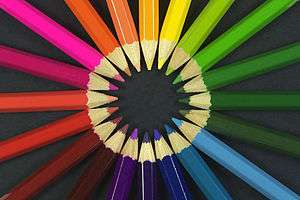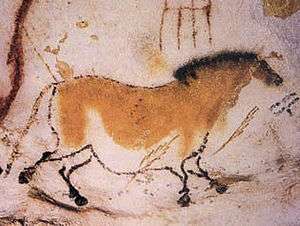Outline of the visual arts

Colour is an important aspect of many of the
visual arts.
The following outline is provided as an overview of and topical guide to the visual arts:
Visual arts – class of art forms, including painting, sculpture, photography, printmaking and others, that focus on the creation of works which are primarily visual in nature. Visual Arts that produce three-dimensional objects, such as sculpture and architecture, are known as plastic arts. The current usage of visual arts includes fine arts as well as crafts, but this was not always the case.
Types of visual art
- Architecture, process and product of planning, designing and construction. Architectural works, in the material form of buildings, are often perceived as cultural and political symbols and as works of art.
- Arts and crafts
- Asemic writing
- Animation
- Calligraphy
- Cartoon
- Ceramic art
- Collage
- Comics
- Conceptual art
- Decollage
- Decorative art
- Design, as a verb, it refers to the process of originating and developing a plan for a new object (machine, building, product, etc.). As a noun, it is used both for the final plan or proposal (a drawing, model, or other description), or the result of implementing that plan or proposal (the object produced).
- Drawing
- Film
- Found art
- Graffiti
- Illustration
- Installation art
- Land art
- Mail art
- Mixed media
- Painting
- Photography
- Printmaking
- Sculpture
- Typography
- Video art
History of the visual arts
By location
|
|---|
| | Sovereign states | |
|---|
| |
- Abkhazia
- Kosovo
- Nagorno-Karabakh
- Northern Cyprus
- South Ossetia
- Transnistria
|
|---|
| |
- Åland
- Faroe Islands
- Gibraltar
- Guernsey
- Jersey
- Isle of Man
- Svalbard
|
|---|
|
|
|---|
| | Sovereign states | |
|---|
| |
- Abkhazia
- Nagorno-Karabakh
- Northern Cyprus
- Palestine
- South Ossetia
- Taiwan
|
|---|
| |
- Christmas Island
- Cocos (Keeling) Islands
- Hong Kong
- Macau
|
|---|
|
Elements of art
Elements of art – shape, form, value, line, color, space and texture
- Shape – area defined by edges
- Form – perceived volume or dimensionality
- Value – use of lightness (tint, or white) and darkness (shade, or black) in a piece of art
- Line – straight or curved marks that span a distance between two points. For example, see line art.
- Color – produced when light, striking an object, is reflected back to the eye.
- Space – area that an artist provides for a particular purpose. Space includes the background, foreground and middle ground, and refers to the distances or area(s) around, between, and within things.
- Texture – the way a three-dimensional work actually feels when touched, or the visual "feel" of a two-dimensional work
General visual art concepts
Visual artists
See also
External links
Outlines |
|---|
| General reference
- Culture and the arts
- Geography and places
- Health and fitness
- History and events
- Mathematics and logic
- Natural and physical sciences
- People and self
- Philosophy and thinking
- Religion and belief systems
- Society and social sciences
- Technology and applied sciences
|
|


